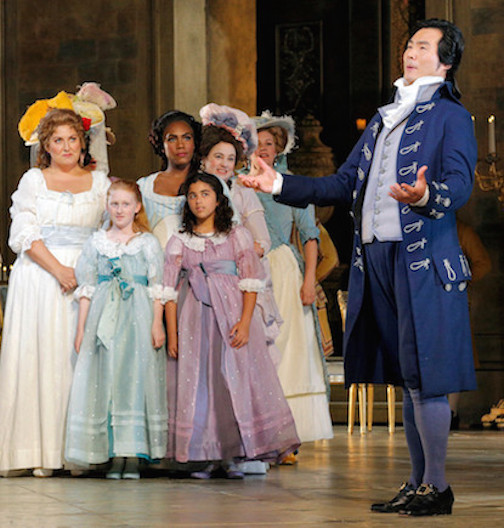
There is no revolution without words
It seems poets are at the center of San Francisco Opera’s opening productions in the 2016 season. While Dream of Red Chamber is laced with the elegant poetry of the unrequited and doomed lovers Bao Yu and Dai Yu, Umberto Giordano’s Andrea Chénier exalts and mythologizes an 18th-century French poet, whose most notable writing was achieved in a French prison, while its author waited for the chop of the guillotine.
In both cases, poetry is a pristine and untouchably pure life, one uncluttered by materialism and that offers an antidote to political cruelties. (Is that why poetry has fallen by the wayside in our own deeply materialistic world?) But in both operas, although poetry offers solace and a moral compass, its poets are doomed. As doomed as the love that inspires their lyrics.
The blood-soaked tricoleur that separates the scenes is decorated with the Jacobin Robespierre’s words: Even Plato banned poets from the Republic.
Set during The Terror of the French Revolution, Giordano’s verismo opera presents players on both sides of the social scale who during this extraordinary and chaotic time become more and more entwined emotionally and politically. The opera opens in the lavishly presented château of the aristocratic family di Coigny. While the servants prepare for the evening festivities, the bitter servant and footman Gérard sings of his anger, the virtual enslavement of his aging father and his own desolate subservience. Gérard is sung by baritone George Gagnidze, who grips the role with fervor.
Preparations ended, the château fills with frivolous aristocrats, dressed in gold and white, lavender and aqua. A ballet of shepherds and shepherdesses in powdered wigs and dainty outfits dances to the songs of a chorus. To continue the entertainment, the Countess asks Chénier, who has been brought to the event by another writer and musician, to recite his verses. Chénier refuses. But the young Maddalena teases the serious-minded poet into improvising. His poetry is full of revolutionary anger. Maddalena is shamed, and Gérard inspired.
From this moment on these three characters become the opera’s emotional focus, as the opera winds away from aristocratic pleasantries and deeper into the revolution. In the second act, set five years later in a café in Paris, Chénier, now a revolutionary journalist, will again encounter Maddalena, who has gone into hiding to escape Robespierre’s slaughter of aristocrats.
The role of Andrea Chénier is sung by tenor Yonghoon Lee, who has a forceful sound which never seems to move into more tender dynamics even in his declarations of love. But his sound and presentation are stirring, and the audience was pleased with his vigorous singing. Anna Pirozzi, who sang Maddalena, has more dynamically subtle control. Her voice is beautiful and its lyrical clarity is especially noticeable in softer passages of her singing.
The footman Gérard is later in placed in a position remarkably similar to Scarpia, wresting sexual favors from the unwilling Maddalena di Coigny, whom he has long adored. But unlike Tosca’s evil nemesis, Gérard is a sympathetic character, his love more generous and sincere. When Maddalena sings of her love for Chénier, he relents, and helps her join her poet in prison where the two will go to the guillotine, hand and hand.
There were many excellent performances by this rather large cast. And numerous debuts, including the three leads. David McVicar directed the production, which originated in 2015 at Covent Garden in London. Maestro Nicola Luisotti belted it out on the podium. The orchestra was splendid, as always.
– Jaime Robles
Photo: Anna Pirozzi (far left) and Yonghoon Lee (right) in the title role of Andrea Chénier, in San Francisco Opera’s production of the Giordano opera. Photo by Cory Weaver.
